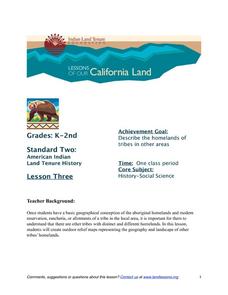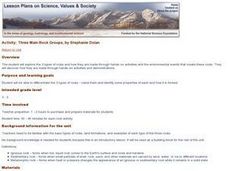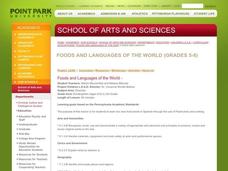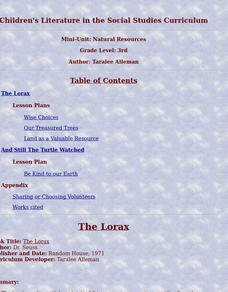Curated OER
Science Unit Lesson Five
Sixth graders review how and which plants operate in terrariums. In groups, they follow instructions to make their own terrarium and place different types of plants in it. To end the lesson, they review the steps in the water cycle and...
Indian Land Tenure Foundation
More Tribal Homelands
Here is a very fun idea that introduces young learners to how geographical location affects cultural development. They are introduced to four areas where Native Americans have lived in the past by reading stories and examining images....
NASA
Biology Training Module
Are you a koalafied biologist? The lesson begins with research about human survival and our ecosystem. Then, an online training module simulates the effects of changes to the plants and animals in an ecosystem. Finally, scholars research...
NOAA
Through Robot Eyes
How do robots assist ocean explorers in collecting data and images? The final installment in a five-part series has science scholars examine underwater images collected by robots and identify the organisms shown. Groups then calculate...
Curated OER
Safe Food Supplies
Young scholars answer the question how are food supplies maintained safely for human consumption? They are able to answer the following questions: what personal and pulic decisions must be made regarding the safe handling of food?, What...
Curated OER
How Much of Each Nutrient Does Your Body Need, and How Can You Find Out What Is In Each Food?
Fifth graders practice reading food labels to find nutrients in foods. In this health lesson, 5th graders read food labels and discuss the recommended daily allowance of each nutrient. They compare this to the food pyramid and create a...
Curated OER
Dietary Guidelines/Food Pyramid
Students study the recommended Dietary Guidelines for Americans and the Food Guide Pyramid. They discuss the foods they eat, watch a video about the Food Pyramid and examine actual foods portioned out into recommended serving sizes.
Curated OER
Internet Scavenger Hunt
Students use a computer and the internet to click on highlighted words to find certain answers. They then write the answer to the questions on paper. Finally, students choose one animal to write about. They research the animal on the...
Curated OER
Basics of Environmental Science
Ninth graders explore environmental concerns of the community and identify the basic needs of people, wildlife and domestic animals. Working both individually and in groups, they also define natural resources and compare and contrast...
California Polytechnic State University
Australian Geography Unit
At the heart of this resource is a beautifully detailed PowerPoint presentation (provided in PDF form) on the overall physical geography of Australia, basic facts about the country, Aboriginal history, and Australia culture and lifestyle.
Curated OER
Test Your Speaking & Listening Skills: Lucky Dip 2
Sometimes your English language learners don't need structured speaking practice to build oral fluency. This fun trivia worksheet provides them several opportunities to talk. In groups, they must list three countries in Asia, three...
Curated OER
What Food Is It?
Students close their eyes and taste foods without using the sense of sight to identify the foods. They record what they think the food is that they tasted.
Curated OER
Three Main Rock Groups
Learners are introduced to igneous, sedimentary and metamorphic rocks. They use foods to demonstrate the basic formation of each type of rock, read books about rock formation and view related videos.
Curated OER
Who Eats Who?
Learners recognize that some animals eat plants, some eat meat and some both. In this who eats who lesson, students chart animals in a food chain. Learners research information from reading articles. Students chart what animals eat on...
Curated OER
Making Ships Biscuits
Young scholars research the types of foods that sailors would eat. They focus on "Ships Biscuits" and discuss the role they played in provided sailors' food. They then make the biscuits. They research the rules of basic food hygiene and...
Curated OER
Foods and Languages of the World
Students review Mexico's location and language and learn to pronouns 10 new Spanish food words. Students listen as the book, Corn is Maize is read, touching and passing around an ear of Indian corn. Students discuss the contribution of...
Curated OER
Pyramid Panic Lesson
Students research human health by identifying fatty and sugary foods. In this food choices lesson, students discuss the five food groups and examine the healthiest choices from each group. Students utilize the web to complete a health...
Curated OER
Do You Need What I Need?
Student identify the basic human needs. In this life science lesson, 3rd graders compare the needs of plants, animals and humans. They apply what they have learned by playing a survival team game.
Curated OER
You Are What You Eat (Grades 5-8)
Students gain an enhanced understanding of the relationship between proper nutrition and good health. Through use of video, hands-on activities and interaction, students measure energy in food, and recognize sources of vitamins and...
Curated OER
Ecosystem Game
Students examine the ecosystem by playing a game. In this ecosystem instructional activity, students are put into groups of decomposers, consumers, and producers. Students create a list of animals that fit into each group and items that...
Curated OER
Land as a Valuable Resource
Students investigate why the soil is important to our lives. In this natural resources lesson plan, students have a farmer as a guest speaker. Students begin to understand how farmers use and protect our natural resource. Students write...
Curated OER
Native American Foods
Students explore Native American foods. In this middle school mathematics lesson, students research the types of foods Native Americans across the country typically ate. Students summarize a recipe in their own worlds.
Curated OER
Food Foldable
Second graders read the poem, "Balanced Diet" and cut out the food foldable inserts. They fold the food foldable in half and cut on the dotted lines. They then unfold the food foldable and weave through inserts through the openings,...

























